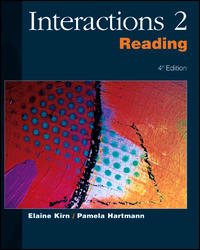 |  Interactions 2 Reading, 4/e Elaine Kirn
Pamela Hartmann
A New Treatment for Back Pain| Announcer: It looks like alternative medicine. Some physicians would be quite skeptical.Doctor: Tell me when you feel it.Announcer: Patients with back pain are zapped with electrical current passing through acupuncturelike needles all in an effort to relieve pain. But it's taking place at UT Southwestern Medical Center at Dallas. Patients who've tried everything, like Doris Dorry, who's battled back pain for twenty-five years, claim it's a lifesaver. So where would you say, using this system, you are on a scale of one to ten?Doris: I was at ten, and I'd gotten down to about eight and a half.Announcer: And that's a lot of relief for you?Doris: Oh yes. Oh yes.Doctor: Judy has had three surgical procedures on her back, as you could see.Announcer: Judy Ellis started getting treatments last year, in April, after everything from surgery to steroids failed to help. She describes her situation before the sessions with the pain needles as hopeless. Now, she can literally fall asleep during a session, it's so relaxing. And she says she has a whole new future.Judy: I'm not ready yet, but I hope to dance again, ski, and do things that I love to do, because all that has been, you know, taken away from me as a result of the pain.Doctor: We irritate small little nerve fibers so that the information that we're sending in is carried to the spinal cord and up the spinal cord to the brain.Announcer: That stimulation interrupts the pain message being sent to the brain. The electrical stimulation isn't a magic bullet, though. The pain relief is gradual, and may not be complete. Doctors are encouraged, though, because it gives patients renewed hope. |
|



 2003 McGraw-Hill Higher Education
2003 McGraw-Hill Higher Education

 2003 McGraw-Hill Higher Education
2003 McGraw-Hill Higher Education